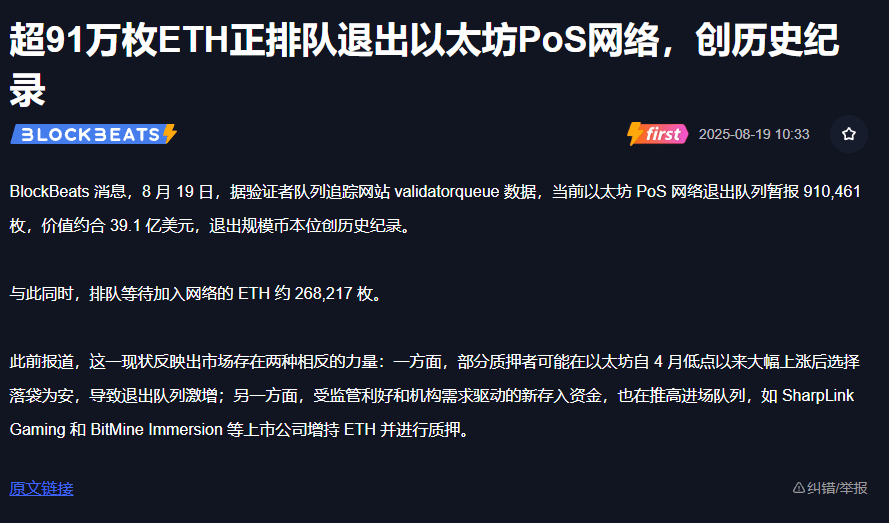Brothers, something big has happened!
The latest data from validatorqueue revealed a bombshell: The amount of ETH exiting staking in the Ethereum PoS network has soared to 910,461, worth $39.1 billion at current prices, a historical high in terms of currency.
This is clearly old players 'withdrawing and leaving'. A group of whales took advantage of ETH's rise from the April low to cash out quickly. Such a large-scale selling pressure could really create a big pit in the market.
On the other hand, 268,217 ETH are queued to enter the market. Behind this is favorable regulation and institutions scrambling to buy, like SharpLink Gaming and BitMine Immersion, which are increasing their ETH holdings for staking. Fresh institutional funds are 'taking over' and even competing.
The market is currently torn: the exit wave is the bulls cashing out, indicating potential selling pressure; while the entry wave is new money coming in, showing that the medium- to long-term belief in ETH is strengthening.
It's like tug-of-war, with old players leaving while new institutions take over. Who has more strength will determine whether Ethereum will crash or enter a second wave of a bull run.
This 'staking offensive and defensive battle' is not only about ETH but also affects the sentiment of the entire crypto circle. If the market interprets it as 'whales fleeing', it could trigger a panic sell-off in the short term; however, if the funding continues to be strong, ETH may enter a new cycle of 'whale turnover' with institutional participation.

The showdown between bulls and bears is brewing. While retail investors cheer for the 260,000 ETH entering the market, the ratio of exiting to entering funds has reached 3.4:1. This is not a healthy turnover; it is profit-taking from new funds. Moreover, the queue to exit takes 37 days, and the selling pressure will last until the end of September, giving bears a natural ammunition stockpile.
On-chain data shows that this exit wave coincides perfectly with the 80% rise of ETH in April. Those whales who built positions below $3000 are now 'harvesting' above $4000. What's more alarming is that the SEC suddenly inspected staking service providers this month, pressuring institutions to passively reduce holdings, creating a double squeeze.
But there are also opportunities for reversal: Companies like SharpLink and BitMine are scrambling to buy 260,000 staked ETH, and BlackRock's ETH spot ETF is also on the way. Historical experience shows that when retail investors panic and exit, it is a good time for institutions to pick up cheap chips. After the Lido staking crisis in 2020, ETH surged by 600%, and this script may repeat.
Emergency reminder: Short-term defense against 'staking yield crashes', the exit wave could drop the annualized APY below 3%, and staking miners may sell ETH to pay user yields. However, in the long term, with the Ethereum Cancun upgrade and ETF dual drive, the selling pressure may clear by the end of September, making it a good time to take off.
My strategy: In the short term, within a month, use the exit queue delay mechanism to gradually buy in the range of $3800-$4000 on the exchange.
Ethereum is staging an epic 'battle for control', with $39.1 billion in selling pressure and 260,000 ETH entering the market, like a powder keg and a match ready to ignite a big trend.
Now is a critical watershed for ETH: will retail investors be scared away by a crash, or will institutions buy at the bottom to ignite the next bull market? I will closely monitor on-chain data to help everyone see through this 'staking mass escape'. Follow me and don't miss this wave!
#CryptoIntegration #ETHStakingExitWatch #StrategyBTCPurchase
Continuously monitor: eth bnb btc



